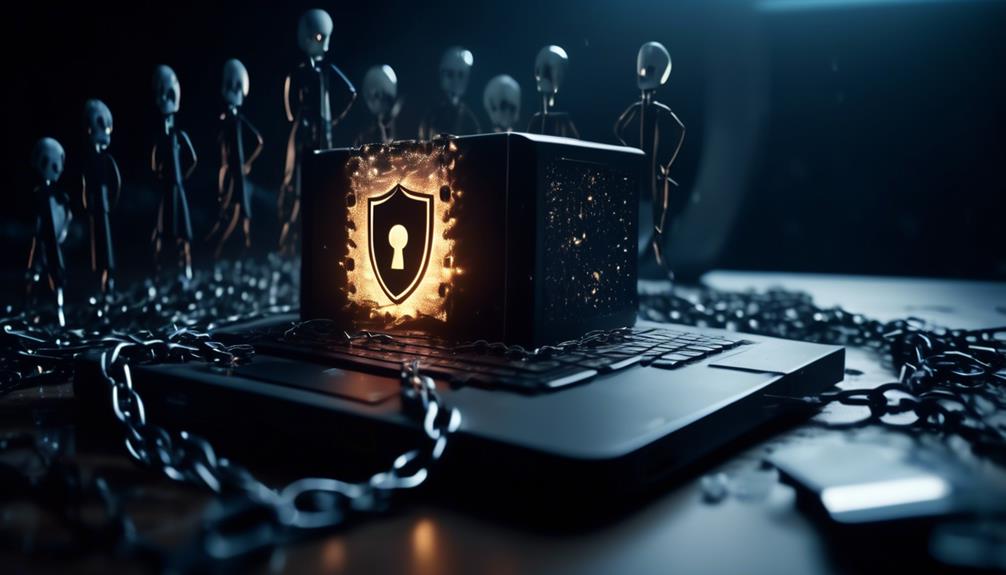Think for a moment, you’ve got a computer that’s not connected to the cloud, it’s offline, safe and secure, right?
You might be surprised to learn that even offline, your files might not be as secure as you think. While it’s true, that hackers generally need internet access to infiltrate your systems, it’s also true that with physical access, no machine is safe.
Now, the question you might be asking yourself is, ‘How can I completely secure my offline data?’
This is where we start to explore some intriguing and often overlooked aspects of data security.
Key Takeaways
- Offline computers are vulnerable to physical breaches and offline hacking methods such as electromagnetic radiation spying and power consumption analysis.
- Malware can compromise the security of a computer not connected to the cloud by giving unauthorized access, collecting and sending personal data, and controlling the computer remotely.
- Implementing strong encryption methods, regularly performing cybersecurity audits, and using secure and encrypted wireless data transfer can help counteract data breaches on offline computers.
- Unsecured connections make sensitive information easy targets, so it is important to use two-factor authentication, password managers, and robust privacy policies for offline computers. Additionally, conducting cybersecurity audits for both online and offline presence is crucial.
Understanding Offline Hacking Methods

While your computer may be safe from online threats when it’s offline, physical access to the device opens the door to various offline hacking methods such as electromagnetic radiation spying and power consumption analysis. These offline hacking methods can compromise air-gapped computers, those isolated from insecure networks, yet physical access remains a prerequisite.
In certain cases, hackers have been known to use the motherboard as a method to gain unauthorized access. By installing malware, they can manipulate the system’s hardware to aid in data transfer. This technique, however, requires skill and advanced knowledge, making it less likely for an average hacker to execute successfully.
Although your computer not connected to the cloud might seem secure, a focused attacker who gains physical access can still pose a threat. This could lead to a breach in your data security or even allow remote management of your device.
To mitigate this risk, strong encryption and vigilant physical security are paramount. For an added layer of protection, consider creating your own cloud for more control over data security. Remember, even offline computers can become targets, so it’s essential to guard them as diligently as online ones.
Role of Malware in Data Theft
You must understand that malware is a significant player in data theft. Threats like viruses, trojans, and ransomware can compromise your system, giving hackers unauthorized access to your sensitive information.
Thus, counteracting these threats and securing your data from breaches becomes an essential part of your cyber security strategy.
Understanding Malware Threats
In the realm of data theft, it’s malware that often plays a pivotal role, compromising both online and offline computers by exploiting security vulnerabilities. Understanding malware threats is crucial to safeguarding your personal data.
Various types of malware, once they gain access to your computer, can collect and send your personal data to an infected network. A single piece of malware can even control your computer remotely if not detected and eliminated by security software. Therefore, it’s critical to keep your security software updated to minimize the risk.
Counteracting Data Breaches
Having explored the dangers of malware threats, it’s time to tackle the role it plays in data breaches, and more importantly, how to counteract these violations.
Your computer stores vast amounts of personal and sensitive data. Ensuring the security of this information should be a top priority, even when the computer isn’t connected to a network or the cloud.
Consider the following measures to strengthen your data security:
- Implement strong encryption methods to protect your data.
- Regularly perform a cyber security audit to identify potential vulnerabilities.
- Utilize a method of wireless data transfer that’s secure and encrypted.
- Be conscious of physical access to your computer.
- Protect against malware threats that can exploit these physical access points.
In a world where data breaches are increasingly common, these steps can provide a crucial line of defense.
Unsecured Connections and Security Risks

While offline computers might seem invulnerable to internet hackers, they’re still susceptible to physical breaches and advanced hacking methods, highlighting the importance of securing unconnected devices against potential security risks.
Unsecured connections make your sensitive information the low-hanging fruit for hackers. Without proper security, anyone with physical access to the computer can gain access to your files. Many individuals and businesses overlook this risk, and only conduct a cybersecurity audit for their online presence.
To stay safe online and offline, consider implementing measures such as Two-Factor Authentication and using a password manager. Remember to always have a robust privacy policy in place, even for offline computers.
Here’s a quick guide:
| Tips | Online | Offline |
|---|---|---|
| Two-Factor Authentication | Yes | Yes |
| Password Manager | Yes | Yes |
| Privacy Policy | Yes | Yes |
| Cybersecurity Audit | Yes | Yes |
| Secured Cloud vs Unsecured Cloud | Secured | N/A |
Ransomware: A Hacker’s Tool
Ransomware is a potent tool in a hacker’s arsenal. It can cripple your system by encrypting files and demanding payment for their release. Understanding this threat is crucial. This includes understanding its deployment methods and its damaging effects.
Implementing preventive measures is essential in protecting yourself from ransomware attacks. Regular system updates can help close vulnerabilities that hackers exploit. Using robust anti-malware software can also shield you from such breaches.
Taking these precautions can significantly reduce the risk of falling victim to ransomware attacks. It is important to stay informed about the latest developments in ransomware and to be proactive in safeguarding your system.
Understanding Ransomware Attacks
To truly grasp the threat of ransomware, you need to understand that it’s a tool hackers frequently use to encrypt a victim’s files, demanding payment to restore access. Often, they’ll exploit vulnerabilities in your remote desktop services or trick you into downloading malicious software from an email. They might also use your login credentials, stolen from places like Canada’s Personal Information Protection Act (PIPA) or the Amazon Web Services (AWS) platform.
Ransomware attacks follow a general pattern:
- Infiltration: via email phishing, USB drive, or exploiting system vulnerabilities.
- Encryption: valuable data on your computer or External Hard Drive is encrypted, making it inaccessible.
- Ransom note: detailing payment methods, usually in untraceable cryptocurrencies.
- Payment: if paid, a decryption key is provided.
- Regain control: restoring files and removing ransomware traces.
Preventing Ransomware Breaches
In this age of increasing digital threats, it’s crucial for you to understand how to prevent ransomware breaches and fortify your computer against potential attacks, whether it’s connected to the internet or not. Your first line of defense is reliable anti-virus software, regularly updated to counter zero-day exploits.
Beware of phishing messages and fake websites, as these are common methods that could lead your computer to be hacked. The main downside of being connected to the internet is that it makes your system vulnerable to attacks, potentially exposing data on the infected computer.
Using strong passwords, two-factor authentication, and encryption are also key in preventing ransomware breaches.
Ultimately, staying informed and vigilant is your best protection against these digital threats.
Phishing Scams and Social Engineering

Phishing scams and social engineering are two prevalent strategies that hackers employ to trick you into revealing sensitive information, thereby gaining unauthorized access to offline computer files. Phishing typically occurs via deceptive emails or websites, while social engineering relies on psychological manipulation.
Hackers have developed another complicated tactic to extract data from air-gapped computers, those not connected to the internet: They remotely manipulate the computer video card automatically to emit electromagnetic signals. This is done by attaching a small device onto the targeted machine which then picks up these signals. The device, often no bigger than a 92-centimeter square, can be easily hidden or disguised.
To protect yourself from these tactics, consider the following:
- Be wary of suspicious emails and websites.
- Never provide sensitive information to unverified sources.
- Regularly update and patch your systems.
- Install reliable security software.
- Be aware of the physical security of your devices.
In essence, while it’s true that an offline computer presents more of a challenge to hackers, it’s not impenetrable. Your best defense is staying informed and vigilant.
Implementing Effective Anti-Hacking Measures
Let’s delve into the world of effective anti-hacking measures, starting with the premise that any computer, even offline ones, can be a hacker’s target, making it crucial to implement comprehensive security strategies.
Always make sure to prioritize your data’s protection. This begins with ensuring that you wipe your hard drive regularly to prevent a hacker from implanting a small device onto the computer, which can transmit data via radio signals.
In a more complicated tactic to extract data, hackers can intercept the most secure content through your computer’s video card. This is why every computer video card should be updated and secured frequently.
Implementing effective anti-hacking measures also includes using strong encryption to make data access difficult for unauthorized individuals.
Frequently Asked Questions
Can a Computer Be Hacked if It’s Not Connected to the Internet?
Yes, even if you’re not connected to the internet, hackers can access your files. However, they’d need physical access to your machine. Advanced tactics like electromagnetic radiation spying could potentially be used, but they’re still experimental.
Can Hackers Access Files Your Computer?
Yes, hackers can access your files if they gain physical access to your computer. Without internet connectivity, they can’t remotely infiltrate, but they could still access files directly on your machine if it’s left unsecured.
Can You Get Hacked if Offline?
You’re generally safe from internet hackers when offline as they typically need a network connection. However, if they gain physical access, your data could be compromised. Always encrypt and protect your data, even offline.
Can Someone Remotely Access My Computer When It’s Off?
No, they can’t. If your computer’s off and not connected to the internet, it’s essentially unreachable. Hackers need your system to be active and online to infiltrate it. So, sleep easy when you power down.
Conclusion
So, while it’s less likely, hackers can indeed access files on a computer not connected to the cloud. They’d need physical access or advanced techniques, which are still in the research phase.
However, malware, unsecured connections, ransomware, and phishing scams are ever-present threats. Therefore, it’s crucial to implement effective anti-hacking measures.
Stay informed, keep updating your security protocols, and stay one step ahead of potential cyber threats.
